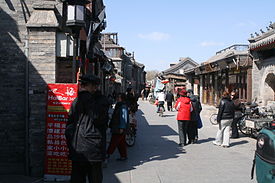
Back Hutong AST Хутун Byelorussian Hutong Catalan Chu-tchung Czech Hutong German Hutong Esperanto Hutong Spanish Hutong Basque Hutong Finnish Hutong French
| Hutong | |||||||||||
|---|---|---|---|---|---|---|---|---|---|---|---|
| Simplified Chinese | 胡同 | ||||||||||
| Traditional Chinese | 衚衕 or 胡同 | ||||||||||
| Literal meaning | (borrowing of Middle Mongolian quddug, "water well") | ||||||||||
| |||||||||||


Hutong (simplified Chinese: 胡同; traditional Chinese: 衚衕 or 胡同; pinyin: hútòng) are a type of narrow street or alley commonly associated with northern Chinese cities, especially Beijing.
In Beijing, hutongs are alleys formed by lines of siheyuan, traditional courtyard residences.[1] Many neighbourhoods were formed by joining one siheyuan to another to form a hutong, and then joining one hutong to another. The word hutong is also used to refer to such neighbourhoods.
Since the mid-20th century, many Beijing hutongs were demolished to make way for new roads and buildings. More recently, however, many hutongs have been designated as protected, in an attempt to preserve this aspect of Chinese cultural history. Hutongs were first established in the Yuan dynasty (1279–1368) and then expanded in the Ming (1368–1644) and Qing (1644–1911) dynasties.
- ^ Michael Meyer. "The Death and Life of Old Beijing".
© MMXXIII Rich X Search. We shall prevail. All rights reserved. Rich X Search